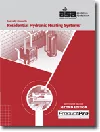UA Program Sets 'Sites' On Residential Construction
Over the past year, the United Association has met with most every local in every state in the union to discuss a new plan to recapture the $320 billion dollar residential construction market.
"Recapture" is the catchword since union labor was at one time just as much a powerhouse in building homes as it is today building commercial/industrial facilities. As it stands now, the UA estimates that nonunion labor commands 90 percent of the national residential construction market. Meanwhile, the union's 10 percent share is concentrated in metropolitan areas that have remained union strongholds for any type of construction.
"Outside of large metropolitan areas of the country, we're almost out of business," admits UA special representative Gary A. Hamilton, who spent much of last year developing the UA's new Residential Program. For example, Hamilton says union labor still completes 95 percent of the residential work in and around his home base of Milwaukee, Wis. He adds that 40 percent of the local union is dedicated to that industry.
The new program covers work on single and multiple family homes, townhouses, condos, apartment buildings and other residential structures no higher than four stories. The agreement covers the installation of plumbing, fire protection and HVAC systems.
With the exception of Massachusetts, Illinois, Kentucky, Northern California and Hawaii, Hamilton has signed on all other states to the new program and begun establishing individual plans to deal with wages and benefits.
High on the UA's list is to eradicate the "feast or famine" aspects of the commercial/industrial sector and offer additional employment opportunities to its members. Hamilton also adds that the UA isn't taking its dominance in commercial/industrial work for granted either.
"While the size of the residential market is enough to justify our efforts to recapture our share, there's another very good reason why we need to once again be a strong presence in the residential market," Hamilton explains. "There's no doubt that whoever dominates the residential market can also eventually dominate the commercial/ industrial market. Nonunion contractors have indeed grown stronger in the residential sector and used it as a springboard into our traditional stronghold of commercial/industry work."
In order to compete in what is basically a market controlled by nonunion labor, the new residential program gives employers wide latitude - wider than they would have in traditional union construction - to determine the size, composition and source of the workforce. While the plan is a national agreement that recognizes the UA as the exclusive bargaining rep, it still can be tailored to meet needs on a state-by-state basis. In some case, the agreement can be tailored on a project-by-project basis.
"We definitely had to realize that the residential workforce is different than a commercial crew," Hamilton adds. "Whereas a commercial crew will begin at 7:30 a.m., end at 3:30 p.m., and have lunch right at noon, there are much less restrictions on a residential crew. These workers may start the day at 6 a.m., or they may start at 8 a.m. and choose to work through lunch. Also, there might just be two workers at a residential job site vs. the many more workers you'd find at an average commercial job site."
The task Hamilton has had to focus on is figuring out wages and benefits. "That varies all over the map," he explains. "In areas where work is abundant, the workers may be making more money than the union scale - but certainly without the union benefits. Then again, in areas where there's an unlimited supply of workers, they might be getting $8 an hour and no benefits.
Considering the nonunion control of the residential sector, organizing labor is an important aspect to making the UA plan work. "That's the tough part," Hamilton concedes. "We need to get back in the residential market in a way that's both beneficial to the contractor and the union."
Training is also an important part of the program. The UA recently put the finishing touches on a three-year curriculum for residential work. (The curriculum can also be expanded. Some states, for example, may require a five-year plan.) The residential plan calls for signatory contractors to contribute 5 cents per hour to the International Training Fund to help underwrite training.
To further promote the benefits of the program, signatory contractors also will contribute a penny per hour to the National Residential Labor-Management Fund. Since quality work is also an important union trump card, part of the marketing campaign includes a five-year warranty on all residential work done by UA members.
"We're guaranteeing the quality, reliability and excellence of our work," Hamilton says. "It's a guarantee that we installed the equipment right the first time - and if we didn't, then we'll make it right at no cost."
Residential Construction
At A Glance
Source: UA research
Looking for a reprint of this article?
From high-res PDFs to custom plaques, order your copy today!





